Assessment of Radon Concentration and Impact on Human Health in a Region Dominated by Abandoned Gold Mine Tailings Dams: A Case from the West Rand Region, South Africa
Abstract
1. Introduction
1.1. Study Area
1.2. Geological and Hydrogeological Overview
2. Materials and Methods
3. Results
3.1. Uranium and Thorium Content in Rocks and Tailings
3.2. Outdoor Radon Concentration
3.3. Spatial Distribution of Radon
3.4. Indoor Radon Levels
3.5. Effective Dose
3.6. Radon Associated Health Impacts
4. Discussion
4.1. Characterisation of Prominent Radon Sources and Distribution in The Outdoor Environment
4.2. Indoor Radon Concentration
4.3. Radon Associated Health Impacts
5. Conclusions
Author Contributions
Funding
Acknowledgments
Conflicts of Interest
References
- National Research Council. Health Effects of Exposure to Radon: BEIR VI; National Academies Press: Washington, DC, USA, 1999. [Google Scholar]
- World Health Organization. WHO Handbook on Indoor Radon: A Public Health Perspective; World Health Organization: Geneva, Switzerland, 2009. [Google Scholar]
- Darby, S.; Hill, D.; Doll, R. Radon: A likely carcinogen at all exposures. Ann. Oncol. 2001, 12, 1341–1351. [Google Scholar] [CrossRef] [PubMed]
- National Research Council. Health Risks of Radon and Other Internally Deposited Alpha-Emitters. In Health Risks of Radon and Other Internally Deposited Alpha-Emitters; National Academies Press: Washington, DC, USA, 1988. [Google Scholar]
- Samet, J.M. Radon and lung cancer. J. Natl. Cancer Inst. 1989, 81, 745–758. [Google Scholar] [CrossRef] [PubMed]
- Lubin, J.H.; Boice, J.D., Jr.; Edling, C.; Hornung, R.W.; Howe, G.R.; Kunz, E.; Kusiak, R.A.; Morrison, H.I.; Radford, E.P.; Samet, J.M.; et al. Lung cancer in radon-exposed miners and estimation of risk from indoor exposure. J. Natl. Cancer Inst. 1995, 87, 817–827. [Google Scholar] [CrossRef] [PubMed]
- Darby, S.; Hill, D.; Deo, H.; Auvinen, A.; Barros-Dios, J.M.; Baysson, H.; Bochicchio, F.; Falk, R.; Farchi, S.; Figueiras, A.; et al. Residential radon and lung cancer—Detailed results of a collaborative analysis of individual data on 7148 persons with lung cancer and 14,208 persons without lung cancer from 13 epidemiologic studies in Europe. Scand. J. Work. Environ. Heal. 2006, 32, 1–83. [Google Scholar]
- Chen, J.; Moir, D.; Whyte, J. Canadian population risk of radon induced lung cancer: A re-assessment based on the recent cross-Canada radon survey. Radiat. Prot. Dosim. 2012, 152, 9–13. [Google Scholar] [CrossRef] [PubMed]
- Ishimori, Y.; Lange, K.; Martin, P.; Mayya, Y.S.; Phaneuf, M. Measurement and Calculation of Radon Releases from NORM Residues; International Atomic Energy Agency: Vienna, Austria, 2013. [Google Scholar]
- Porstendorfer, J. Properties and behaviour of radon and thoron and their decay products in the air. J. Aerosol Sci. 1994, 25, 219–263. [Google Scholar] [CrossRef]
- United Nations Scientific Committee on the Effects of Atomic Radiation. United Nations Scientific Committee on the effects of Atomic Radiation. Sources and effects of ionizing radiation. Sources Eff. Ioniz. Radiat. 2000, 2. [Google Scholar]
- National Research Council. Board on Radiation Effects Research National Research Council. In Evaluation of Guidelines for Exposures to Technologically Enhanced Naturally Occurring Radioactive Materials; National Academy Press: Washington, DC, USA, 1999. [Google Scholar]
- Cecil, L.D.; Green, J.R. Radon-222. In Environmental Tracers in Subsurface Hydrology; Springer: Boston, MA, USA, 2000; pp. 175–194. [Google Scholar]
- Matooane, M.; Phala, N.; Wright, C.Y.; Oosthuizen, M.A. Risk perceptions of dust and its impacts among communities living in a mining area of the Witwatersrand, South Africa. Clean. Air J. 2014, 24, 22–27. [Google Scholar]
- Bench Marks Foundation. Waiting to inhale it. In A Survey of Household Health in Four Mine Affected Communities; Soweto Report; Policy Gap 12 Bench Marks Foundation: Johannesburg, South Africa, 2017. [Google Scholar]
- Leuschner, A.H.; Van As, D.; Grundling, A.; Steyn, A. A Survey of Indoor Exposure to Radon in South Africa. 1989. Available online: https://www.cleanairjournal.org.za/download/aleuschner_et_al_1989.pdf (accessed on 24 October 2019).
- Leuschner, A.H.; Steyn, A.; Strydom, R.; De Beer, G.P. Indoor radon concentrations in South African homes. In Proceedings of the 8. International congress of the International Radiation Protection Association (IRPA8), Montreal, QC, Canada, 17–22 May 1992. [Google Scholar]
- Lindsay, R.; Newman, R.; Speelman, W. A study of airborne radon levels in Paarl houses (South Africa) and associated source terms, using electret ion chambers and gamma-ray spectrometry. Appl. Radiat. Isot. 2008, 66, 1611–1614. [Google Scholar] [CrossRef]
- Kamunda, C.; Mathuthu, M.; Madhuku, M. Determination of Radon in mine dwellings of gauteng province of South Africa using AlphaGUARD radon professional monitor. J. Environ. Toxicol. Stud. 2017, 1. [Google Scholar]
- Lindsay, R.; De Meijer, R.; Maleka, P.; Newman, R.; Motlhabane, T.; De Villiers, D. Monitoring the radon flux from gold-mine dumps by γ-ray mapping. Nucl. Instrum. Methods Phys. Res. Sect. B Beam Interact. Mater. Atoms 2004, 213, 775–778. [Google Scholar] [CrossRef]
- Lindsay, R.; De Meijer, R.J.; Joseph, A.D.; Motlhabane, T.G.; Newman, R.T.; Tsela, S.A.; Speelman, W.J. Measurement of radon exhalation from a gold-mine tailings dam by gamma-ray mapping. Radiat. Phys. Chem. 2004, 71, 797–798. [Google Scholar] [CrossRef]
- Speelman, W.J. Modelling and Measurement of Radon Diffusion through Soil for Application on Mine Tailings Dam. Ph.D. Thesis, University of the Western Cape, Cape Town, South Africa, 2004. [Google Scholar]
- Ongori, J.N.; Lindsay, R.; Newman, R.T.; Maleka, P.P. Determining the radon exhalation rate from a gold mine tailings dump by measuring the gamma radiation. J. Environ. Radioact. 2015, 140, 16–24. [Google Scholar] [CrossRef] [PubMed]
- Pretorius, D.A. The nature of the Witwatersrand gold-uranium deposits. Handb. Strat. Stratif. Ore depos. 1976, 7, 29–88. [Google Scholar]
- Robb, L.J.; Meyer, F. The Witwatersrand Basin, South Africa: Geological framework and mineralization processes. Ore Geol. Rev. 1995, 10, 67–94. [Google Scholar] [CrossRef]
- Robb, L.J.; Charlesworth, E.G.; Drennan, G.R.; Gibson, R.L.; Tongu, E.L. Tectono-metamorphic setting and paragenetic sequence of Au-U mineralisation in the Archaean Witwatersrand Basin, South Africa. Aust. J. Earth Sci. 1997, 44, 353–371. [Google Scholar] [CrossRef]
- Els, B.G.; Berg, W.A.V.D.; Mayer, J.J. The Black Reef Quartzite Formation in the western Transvaal: Sedimentological and economic aspects, and significance for basin evolution. Miner. Deposita 1995, 30, 112–123. [Google Scholar] [CrossRef]
- Coward, M.P.; Spencer, R.M.; Spencer, C.E. Development of the Witwatersrand Basin, South Africa. Geol. Soc. Lond. Spec. Publ. 1995, 95, 243–269. [Google Scholar] [CrossRef]
- Abiye, T.A. Provenance of groundwater in the crystalline aquifer of Johannesburg area, South Africa. Int. J. Phys. Sci. 2011, 6, 98–111. [Google Scholar]
- Abiye, T.A.; Mengistu, H.; Demlie, M.B. Groundwater Resource in the Crystalline Rocks of the Johannesburg Area, South Africa. J. Water Resour. Prot. 2011, 3, 199–212. [Google Scholar] [CrossRef][Green Version]
- Abiye, T.; Masindi, K.; Mengistu, H.; Demlie, M. Understanding the groundwater-level fluctuations for better management of groundwater resource: A case in the Johannesburg region. Groundw. Sustain. Dev. 2018, 7, 1–7. [Google Scholar] [CrossRef]
- Barnard, H.C. An Explanation of the 1: 500 000 General Hydrogeological Map: Johannesburg 2526; Department of Water Affairs and Forestry: Pretoria, South Africa, 2000. [Google Scholar]
- ICRP. Lung cancer risk from radon and progeny and statement on radon. ICRP publication 115. Ann. ICRP 2010, 40, 1–64. [Google Scholar] [CrossRef] [PubMed]
- Rosner, T. The Environmental Impact of Seepage from Gold Mine Tailings Dams Near Johannesburg, South Africa. Ph.D. Thesis, University of Pretoria, Pretoria, South Africa, 1999. [Google Scholar]
- Zhuo, W.; Furukawa, M.; Guo, Q.; Kim, Y.S. Soil radon flux and outdoor radon concentrations in East Asia. Int. Congr. Ser. 2005, 1276, 285–286. [Google Scholar] [CrossRef]
- Murty, V.; King, J.; Karunakara, N.; Raju, V. Indoor and outdoor radon levels and its diurnal variations in Botswana. Nucl. Instrum. Methods Phys. Res. Sect. A Accel. Spectrom. Detect. Assoc. Equip. 2010, 619, 446–448. [Google Scholar] [CrossRef]
- National Nuclear Regulator. Act 47 of 1999, and Regulations. 1999. Available online: http://www.nnr.co.za/wp-content/uploads/2018/07/NNR-ARISTA-disc-clich%C3%A9_3_PRINT.pdf (accessed on 19 November 2018).
- ICRP. Radiological protection in geological disposal of long-lived solid radioactive waste. ICRP publication 122. Ann. ICRP 2013, 42, 1–57. [Google Scholar] [CrossRef]
- Ball, T.K.; Cameron, D.G.; Colman, T.B.; Roberts, P.D. Behaviour of radon in the geological environment: A review. Q. J. Eng. Geol. Hydrogeol. 1991, 24, 169–182. [Google Scholar] [CrossRef]
- Otton, J.K.; Gundersen, L.C.S.; Schumann, R. The Geology of Radon; US Geological Survey: Reston, VA, USA, 1992.
- Levin, M.; Verhagen, B. Application of isotope techniques to trace location of leakage from dams and reservoirs. In The Use of Isotope Hydrology to Characterize and Assess Water Resources in South (ERN) Africa; Abiye, T., Ed.; Water Research Commission: Pretoria, South Africa, 2013; pp. 9–23. [Google Scholar]
- Wronkiewicz, D.J.; Condie, K.C. Geochemistry of Archean shales from the Witwatersrand Supergroup, South Africa: Source-area weathering and provenance. Geochim. Cosmochim. Acta 1987, 51, 2401–2416. [Google Scholar] [CrossRef]
- Wronkiewicz, D.J.; Condie, K.C. Geochemistry and mineralogy of sediments from the Ventersdorp and Transvaal Supergroups, South Africa: Cratonic evolution during the early Proterozoic. Geochim. Cosmochim. Acta 1990, 54, 343–354. [Google Scholar] [CrossRef]
- Gundersen, L.C.; Schumann, R.R.; Otton, J.K.; Dubiel, R.F.; Owen, D.E.; Dickinson, K.A. Geology of radon in the United States. Geol. Soc. Am. Spec. Pap. 1992, 271, 1–6. [Google Scholar]
- Drolet, J.-P.; Martel, R.; Poulin, P.; Dessau, J.-C.; Lavoie, D.; Parent, M.; Lévesque, B. An approach to define potential radon emission level maps using indoor radon concentration measurements and radiogeochemical data positive proportion relationships. J. Environ. Radioact. 2013, 124, 57–67. [Google Scholar] [CrossRef]
- Ielsch, G.; Thieblemont, D.; Labed, V.; Richon, P.; Tymen, G.; Ferry, C.; Robe, M.C.; Baubron, J.C.; Bechennec, F. Radon (222Rn) level variations on a regional scale: Influence of the basement trace element (U, Th) geochemistry on radon exhalation rates. J. Environ. Radioact. 2001, 53, 75–90. [Google Scholar] [CrossRef]
- Sharma, D.; Kumar, A.; Kumar, M.; Singh, S. Study of uranium, radium and radon exhalation rate in soil samples from some areas of Kangra district, Himachal Pradesh, India using solid-state nuclear track detectors. Radiat. Meas. 2003, 36, 363–366. [Google Scholar] [CrossRef]
- Darby, S.; Hill, D.; Auvinen, A.; Barros-Dios, J.M.; Baysson, H.; Bochicchio, F.; Deo, H.; Falk, R.; Forastiere, F.; Hakama, M.; et al. Radon in homes and risk of lung cancer: Collaborative analysis of individual data from 13 European case-control studies. BMJ 2005, 330, 223. [Google Scholar] [CrossRef] [PubMed]
- Krewski, D.; Lubin, J.H.; Zielinski, J.M.; Alavanja, M.; Catalan, V.S.; Field, R.W.; Klotz, J.B.; Letourneau, E.G.; Lynch, C.F.; Lyon, J.L.; et al. A Combined Analysis of North American Case-Control Studies of Residential Radon and Lung Cancer. J. Toxicol. Environ. Heal. Part A 2006, 69, 533–597. [Google Scholar] [CrossRef] [PubMed]
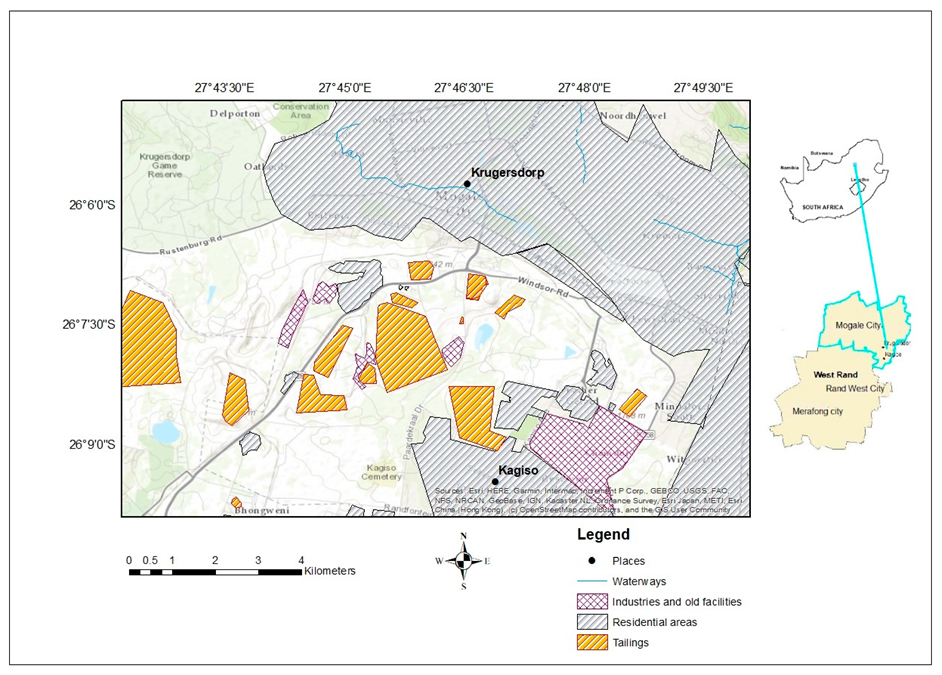
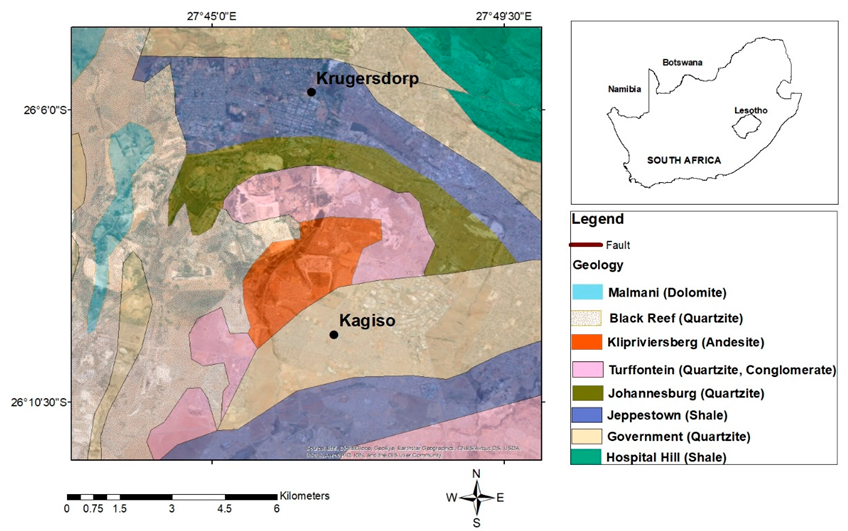
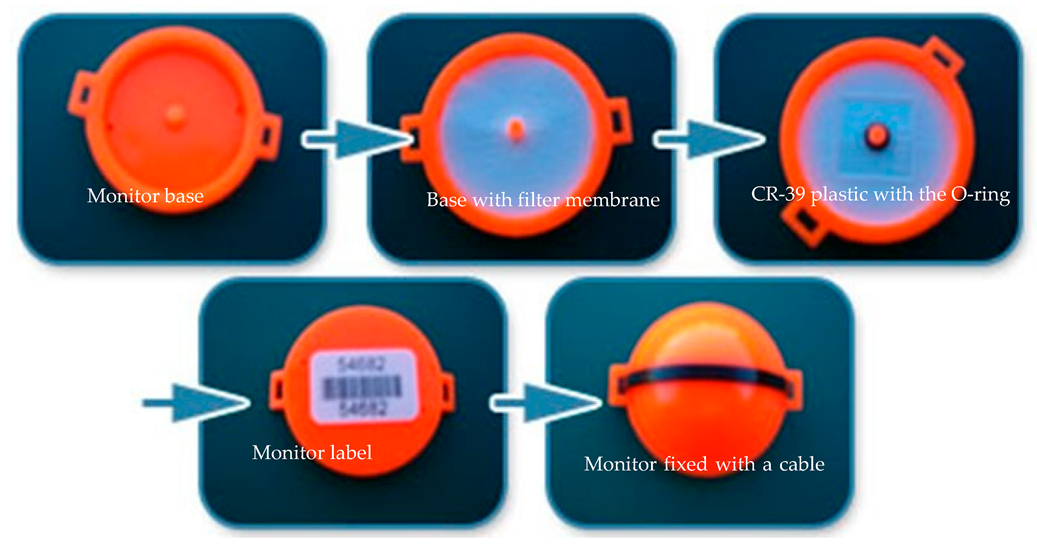
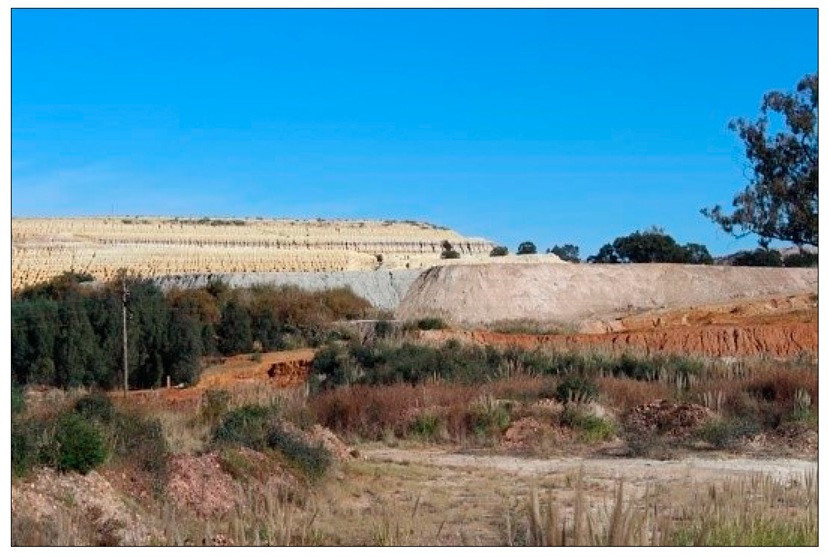

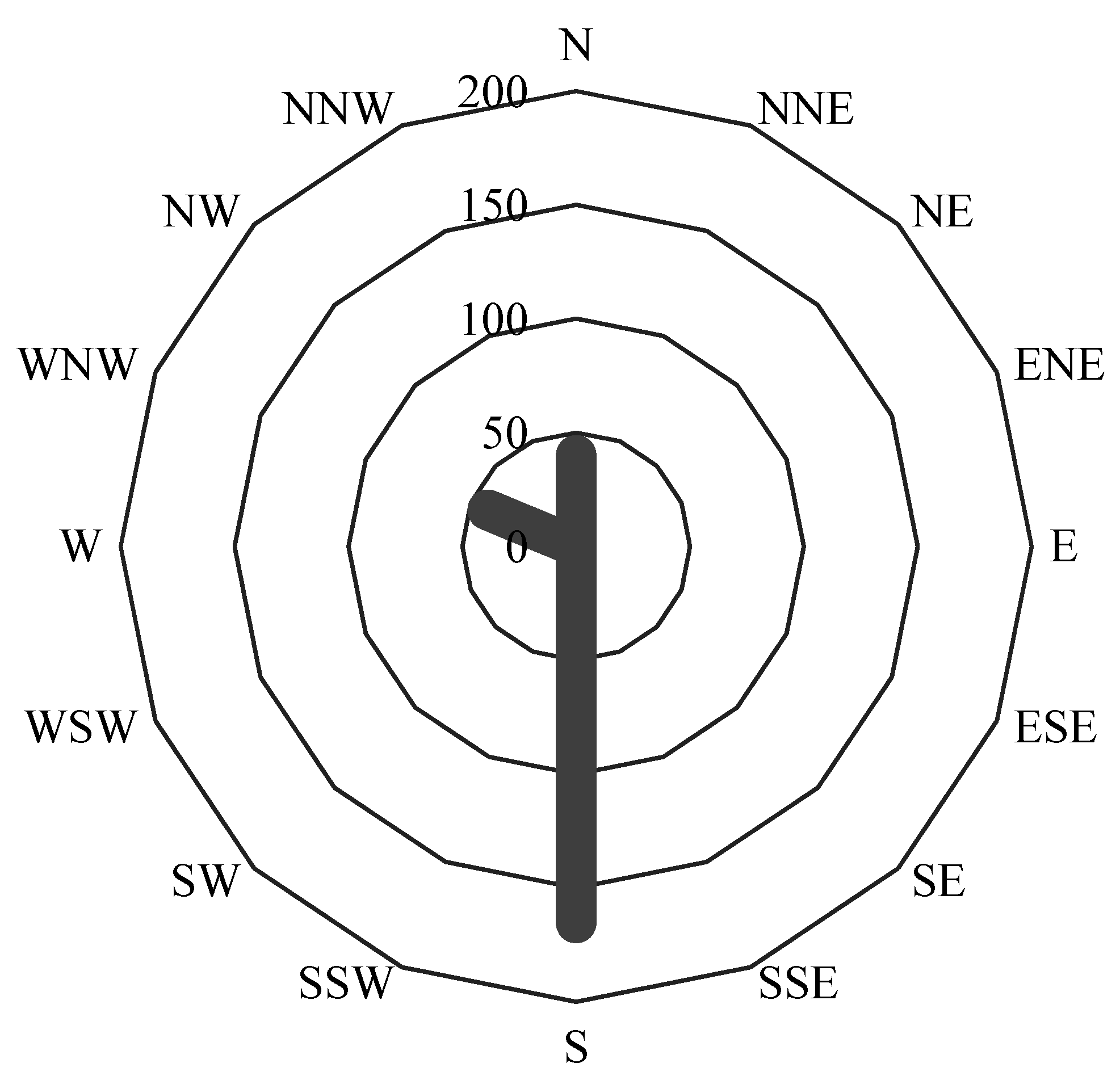
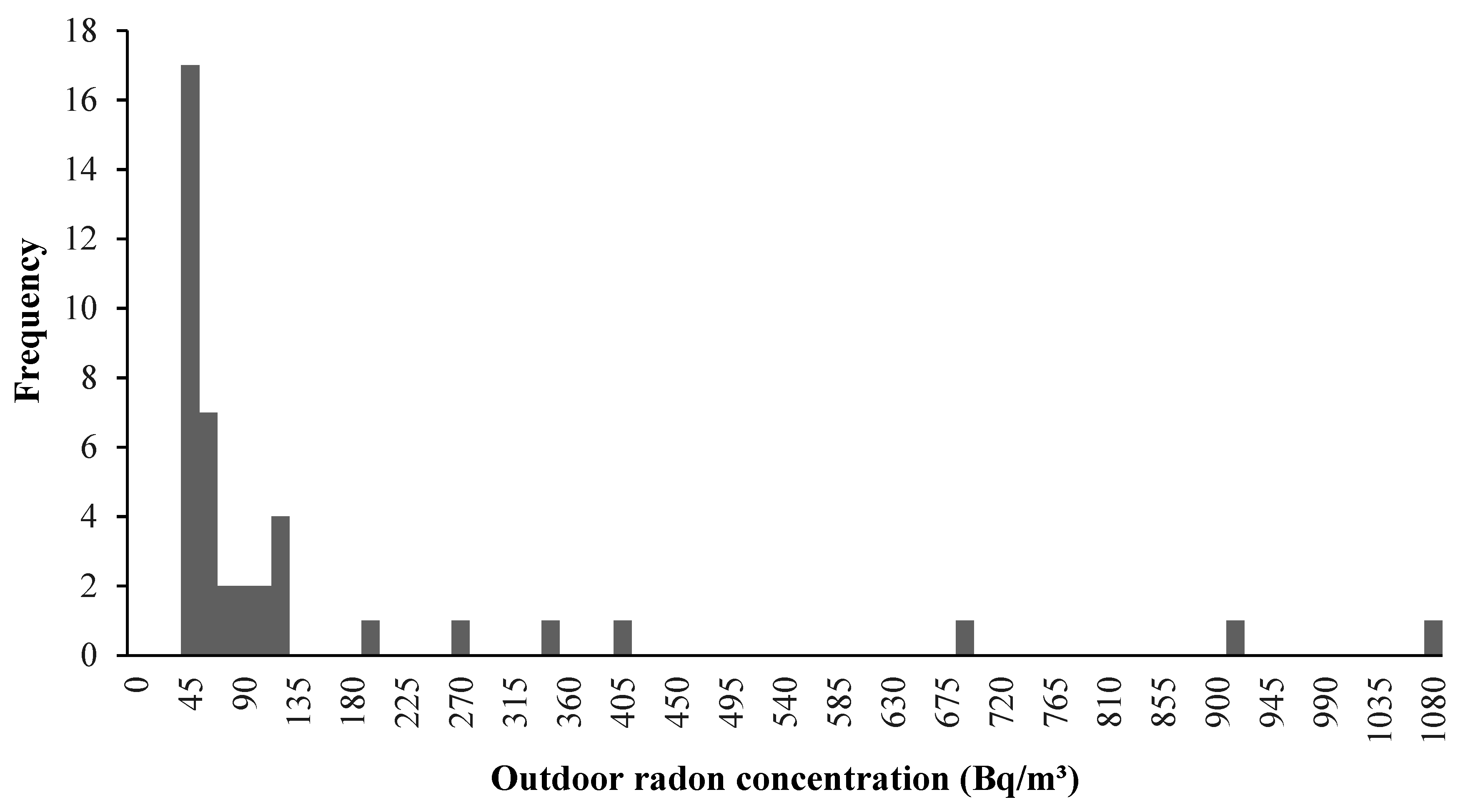
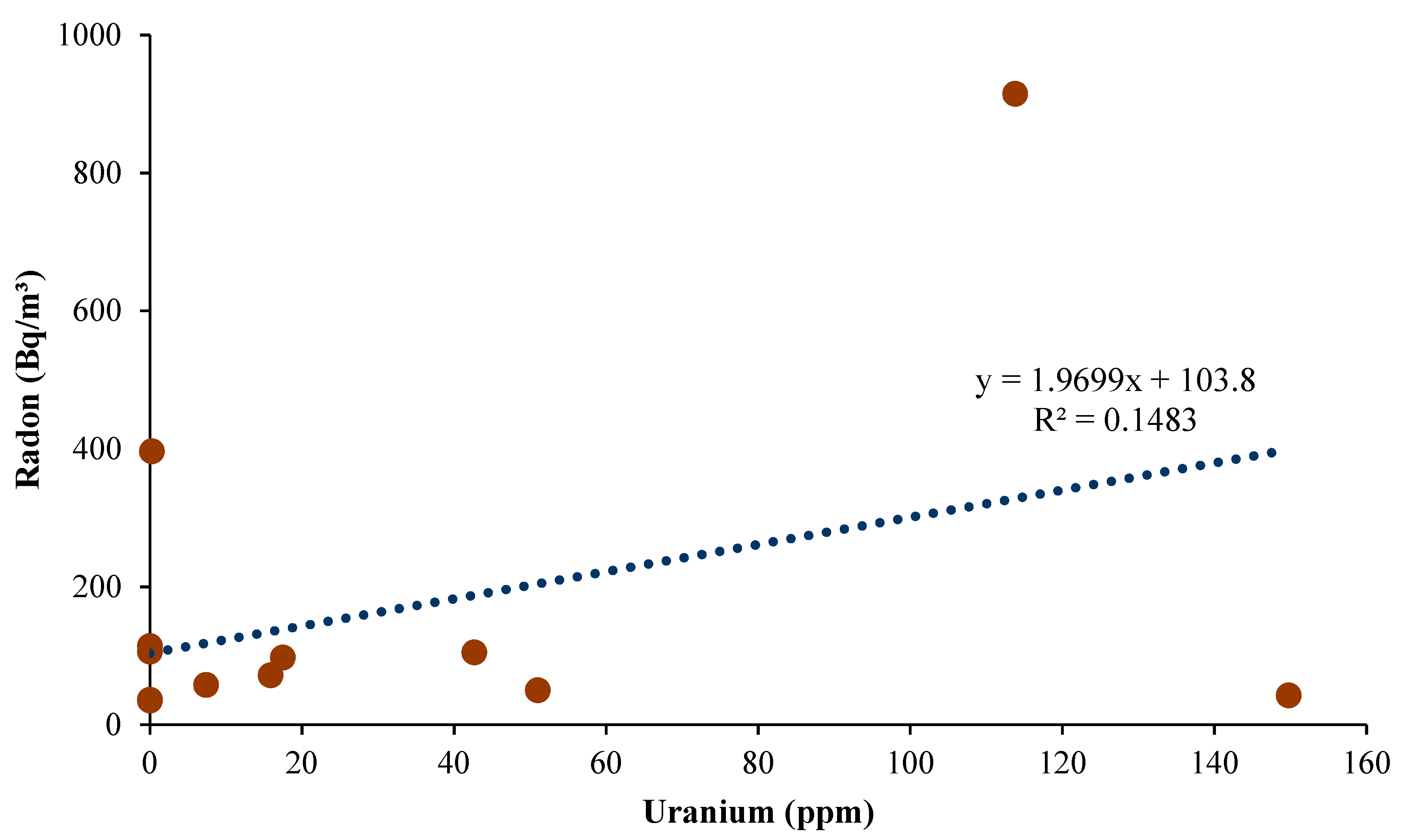
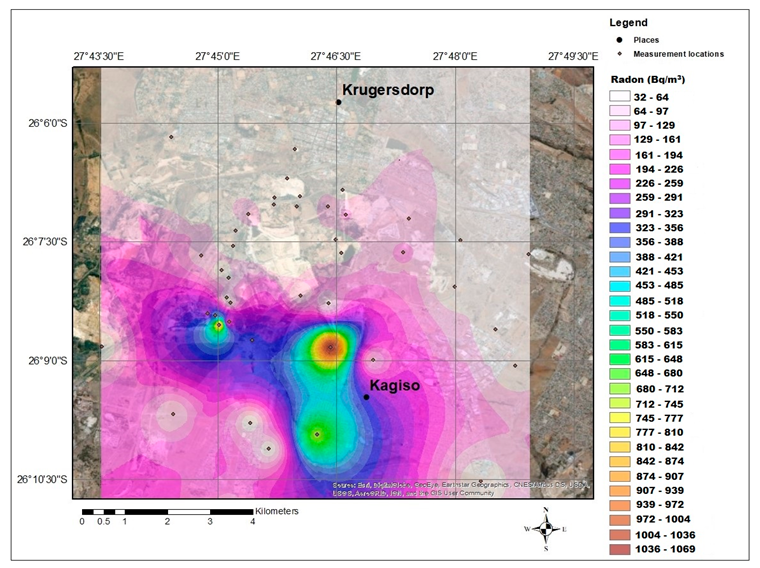
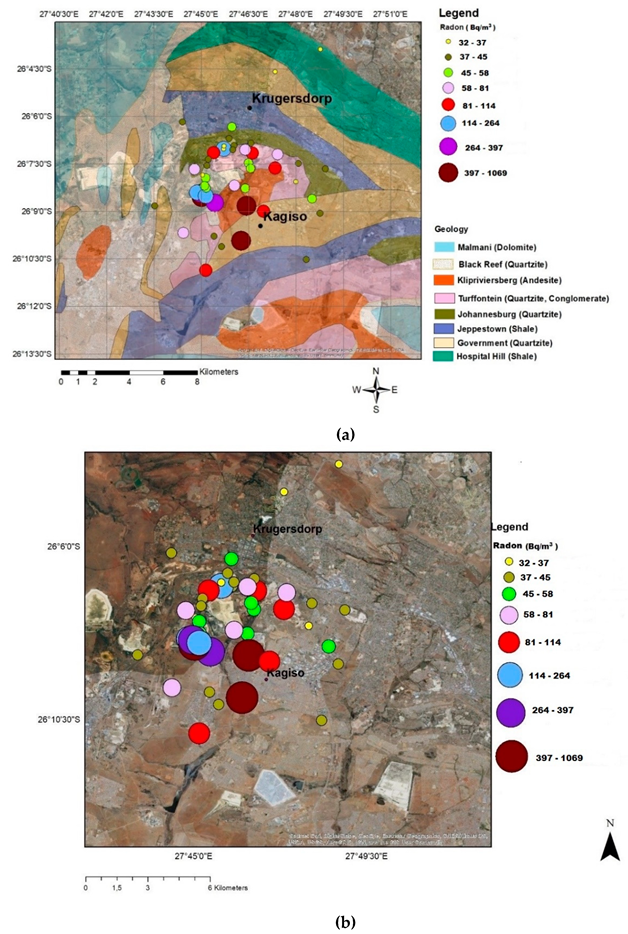
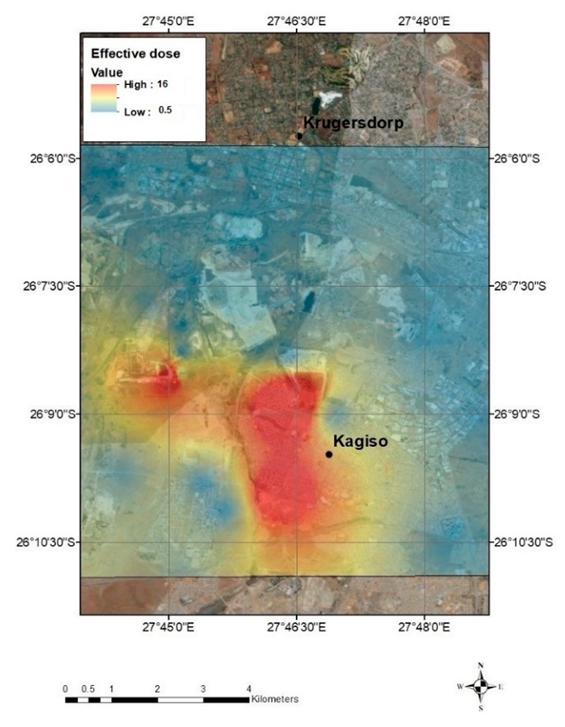
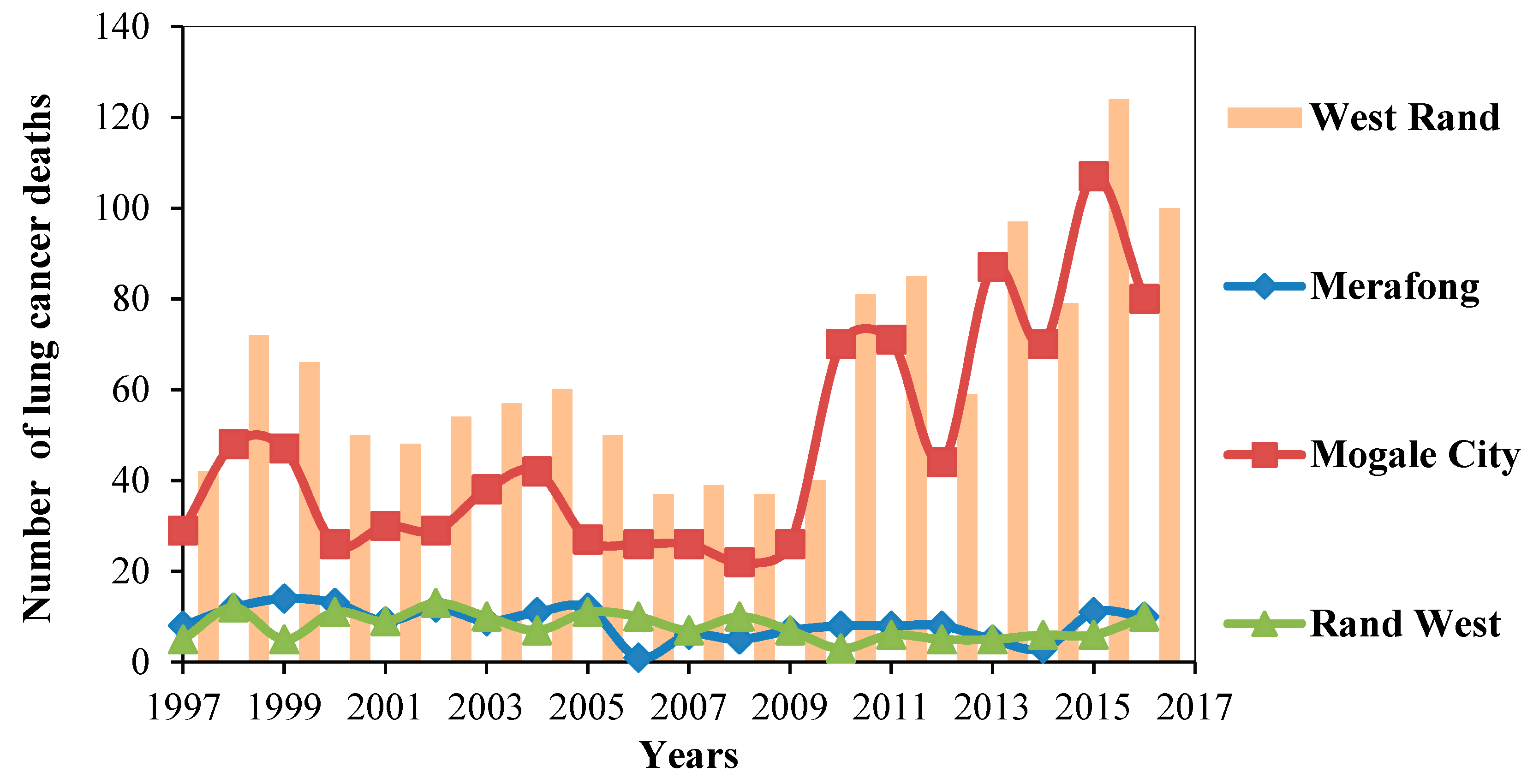
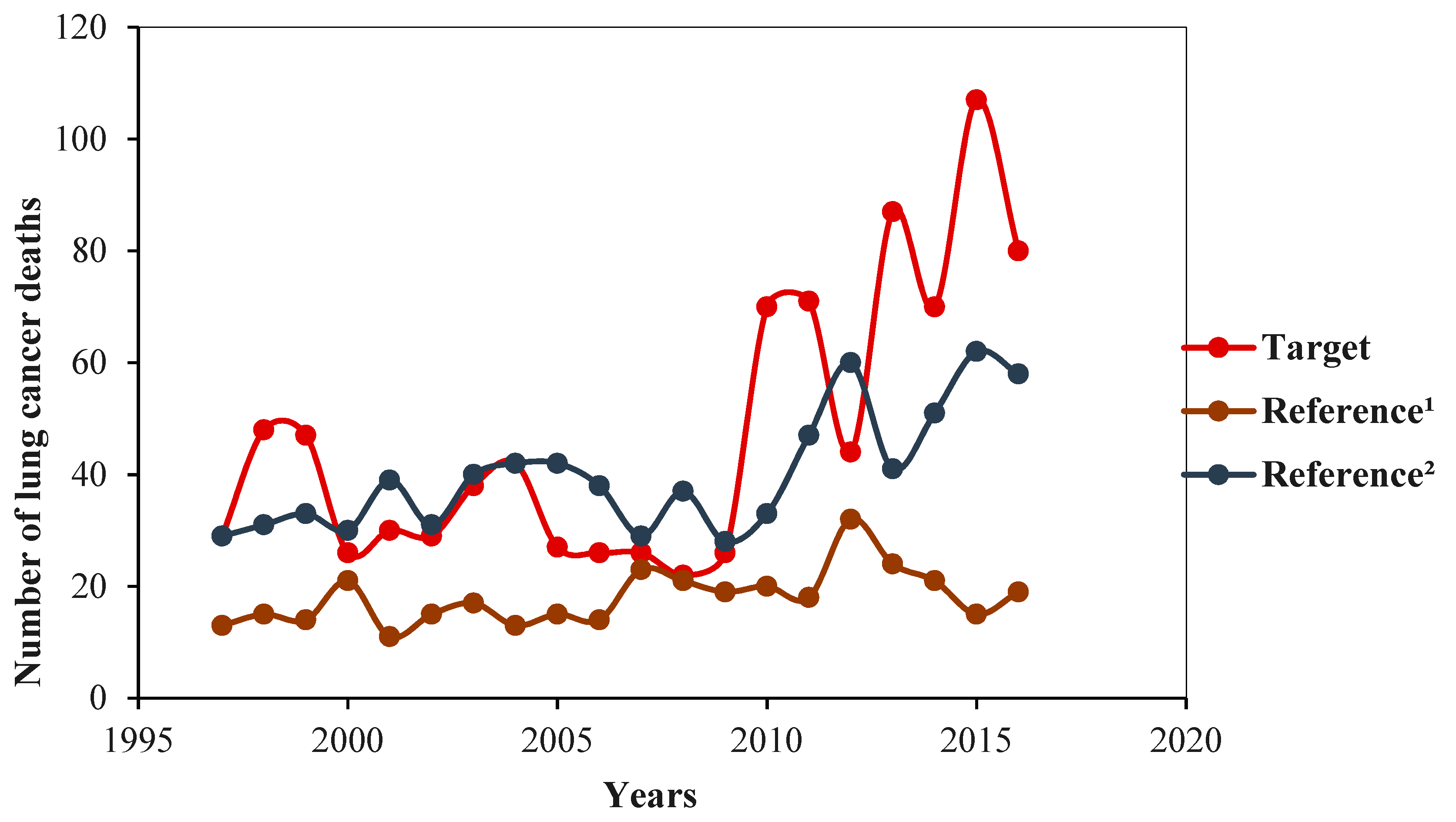
| Elements (ppm) | Tailings Samples Collected in the Field | |||||||||||||
|---|---|---|---|---|---|---|---|---|---|---|---|---|---|---|
| PB01T | PB02T | PB03T | PB04T | PB07T | PB09T | PB10T | PB11T | PB12T | PB15T | PB19T/B | PB19T/B | Mean | SD | |
| U | 42.65 | 51.02 | 7.38 | 74.3 | 28.03 | 15.88 | 17.47 | 0.01 | 113.79 | 149.76 | 85.94 | 0.25 | 48.87 | 48.09 |
| Th | 13.41 | 12.53 | 0.01 | 12.06 | 11.3 | 8.00 | 7.86 | 0.01 | 90.61 | 15.00 | 29.46 | 0.01 | 16.69 | 24.67 |
| Elements (ppm) | Rock samples collected in the field | |||||||||||||
| PB01R | PB04R | PB07R | PB08R | PB10R | PB12R | PB14R | PB16R | PB17R | PB18R | Mean | SD | |||
| U | 0.01 | 0.01 | 0.01 | 0.01 | 0.01 | 1.4 | 0.01 | 0.01 | 0.01 | 0.01 | 0.15 | 0.44 | ||
| Th | 0.01 | 2.9 | 0.39 | 0.65 | 0.01 | 4.47 | 0.01 | 0.01 | 1.26 | 3.11 | 1.28 | 1.63 | ||
| Measurement Location | No of Measurements | Range | Arithmetic Mean | Geometric Mean | Median | Standard Deviation |
|---|---|---|---|---|---|---|
| Directly on tailings | 19 | 37–1069 | 187 | 93 | 58 | 298 |
| Proximity to tailings | 13 | 32–333 | 86 | 65 | 50 | 85 |
| All background measurements | 7 | 40–688 | 148 | 77 | 42 | 240 |
| Background (exclusion to outlier) | 6 | 40–111 | 58 | 53 | 43 | 28 |
| Control | 3 | 30ؘ–37 | 34 | 34 | 35 | 3 |
| All measurements (except controls) | 39 | 32–1069 | 147 | 80 | 55 | 236 |
| Exposed | Range | Mean |
|---|---|---|
| 222Rn (Bq/m3) | 37–174 | 105 |
| Unexposed | ||
| 222Rn (Bq/m3) | 30–51 | 41 |
© 2019 by the authors. Licensee MDPI, Basel, Switzerland. This article is an open access article distributed under the terms and conditions of the Creative Commons Attribution (CC BY) license (http://creativecommons.org/licenses/by/4.0/).
Share and Cite
Moshupya, P.; Abiye, T.; Mouri, H.; Levin, M.; Strauss, M.; Strydom, R. Assessment of Radon Concentration and Impact on Human Health in a Region Dominated by Abandoned Gold Mine Tailings Dams: A Case from the West Rand Region, South Africa. Geosciences 2019, 9, 466. https://doi.org/10.3390/geosciences9110466
Moshupya P, Abiye T, Mouri H, Levin M, Strauss M, Strydom R. Assessment of Radon Concentration and Impact on Human Health in a Region Dominated by Abandoned Gold Mine Tailings Dams: A Case from the West Rand Region, South Africa. Geosciences. 2019; 9(11):466. https://doi.org/10.3390/geosciences9110466
Chicago/Turabian StyleMoshupya, Paballo, Tamiru Abiye, Hassina Mouri, Mannie Levin, Marius Strauss, and Rian Strydom. 2019. "Assessment of Radon Concentration and Impact on Human Health in a Region Dominated by Abandoned Gold Mine Tailings Dams: A Case from the West Rand Region, South Africa" Geosciences 9, no. 11: 466. https://doi.org/10.3390/geosciences9110466
APA StyleMoshupya, P., Abiye, T., Mouri, H., Levin, M., Strauss, M., & Strydom, R. (2019). Assessment of Radon Concentration and Impact on Human Health in a Region Dominated by Abandoned Gold Mine Tailings Dams: A Case from the West Rand Region, South Africa. Geosciences, 9(11), 466. https://doi.org/10.3390/geosciences9110466





